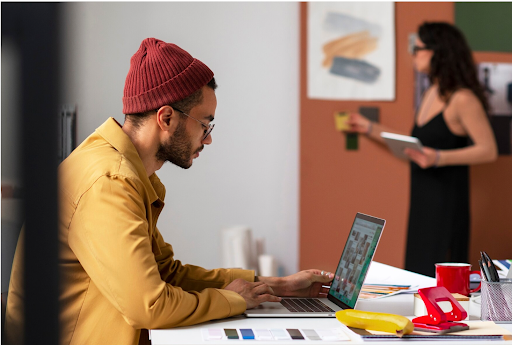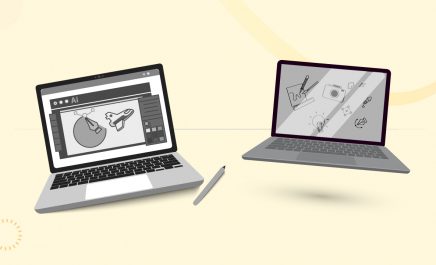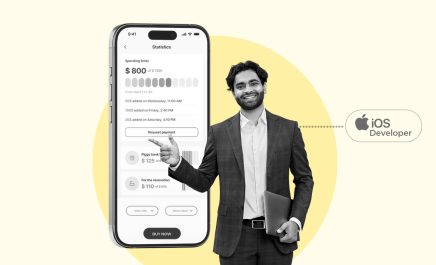How to Onboard a Remote Graphic Designer Successfully
- Visruth Devadas
- July 19, 2024
- 6 Minute Read

An effective onboarding process is crucial for graphic designers, as it fosters strong connections with the creative team and enables them to contribute confidently to projects.
Research shows that organizations with robust onboarding programs see an 82% improvement in new-hire retention and a 70% boost in productivity.
Strategic onboarding for remote graphic designers not only enhances their productivity and job satisfaction but also helps them grasp the company culture and their roles and responsibilities.
Read on to discover best practices for successfully hiring remote graphic designers, ensuring they are well-integrated, motivated, and set up for success.
Pre-Onboarding Preparations
If you want to hire graphic designers, you need to start with effective pre-onboarding preparations.
Here are some key practices for pre-onboarding preparations to ensure a smooth and successful integration of remote graphic designers:
1. Set Clear Expectations
Before assigning work to remote graphic designers, you must define their responsibilities. Help them understand project deadlines, protocols, and key KPIs. Remote graphic designers must know how they can contribute to meeting company goals.
2. Preparing Necessary Tools and Software
You must ensure remote graphic designers can access the necessary tools and software.
You must prepare to supply them with:
- Relevant Hardware: 58% of companies provide hardware to help employees onboard and work remotely. You must provide a suitable computer, monitor, and other tangible resources for graphic design work.
- Secure Software: Grant access to essential design software and set up accounts and permissions for project management tools. Your remote employees should also have access to communication platforms, IT support, and comprehensive guides or tutorials.
3. Creating an Onboarding Schedule
An organized onboarding schedule helps remote graphic designers adapt to their new roles.
A well-structured schedule should include:
- Meetings with key stakeholders.
- Training on company processes, tools, and brand guidelines.
- Mentorship to provide guidance and support during the initial period.
- Project assignments, starting with simpler tasks.
- Check-ins for feedback
Orientation and Training
For graphic designers, remote onboarding should start with a well-organized orientation and training program. This includes:
1. Company Policies and Procedures
You must help remote graphic designers learn company policies and procedures by providing them with a comprehensive handbook. You must also provide them with internal and external resources to learn about the company’s culture, vision, mission, aim, and objectives.
2. Project Management Tools and Processes
Share best practices with remote graphic designers and train them on relevant design management tools and resources. Share policies related to meeting deadlines and ensuring quality control.
3. Design Standards and Brand Guidelines
Ensure that remote graphic designers understand the company’s design standards and brand guidelines. You must explain the standard for creating and delivering design assets and describe the design review and approval process.
4. Providing Access to Design Resources
Equip remote graphic designers with stock photos, icons, and illustrations and help them stay updated with the latest trends and tools. Help them with the latest software, like Adobe Creative Cloud, and offer access to various online educational resources.
Assigning the First Project
The first project is a crucial step in onboarding remote graphic designers, as it sets the tone for their experience and integration into the team.
Here’s how to assign the first project effectively:
1. Select an Appropriate Initial Task
Choose the right first project for a remote graphic designer, making sure it is straightforward and manageable. Help them with a smooth workflow and tools, and ensure the project is relevant to the designer’s skills and expertise.
2. Setting Clear Goals and Deadlines
Here are some tips:
- Clearly define the objectives of the project.
- Set SMART goals and provide clear direction.
- Make expectations clear.
- Break down the project into manageable milestones.
- Communicate the overall deadline for the project.
3. Providing Necessary Resources and Support
Share necessary resources like user guides, FAQs, assets, or documentation that can help the designer understand the project better. Also, ensure the designer knows whom to contact for support and questions. Set up a feedback mechanism where the designer can submit their work for review and receive constructive feedback.
Building a Connection with the Team
Here are some best practices that will help remote graphic designers build a connection with their peers:
1. Scheduling Regular Check-Ins
Regular check-ins are crucial for maintaining communication. It ensures that remote graphic designers feel supported and connected. You can:
- Schedule one-to-one meetings with the designer and encourage them to open up. 72% of new hires consider one-on-one meetings with their managers the most significant part of onboarding.
- Hold regular team meetings to update on project statuses.
- Encourage check-ins for quick updates or immediate issue resolution.
- Organize regular sessions where the designer can receive constructive feedback.
2. Encouraging Team Collaboration and Communication
Your remote graphic designers will feel integrated and valued if you use the following strategies that encourage team collaboration:
- Use appropriate software for real-time communication and file sharing.
- Involve the designer in collaborative projects to work closely with other team members.
- Implement a peer review system where designers can review each other’s work.
- Set shared goals and objectives for the team.
- Promote a sense of unity.
- Encourage an open communication culture where team members feel comfortable sharing ideas.
3. Virtual Team-Building Activities
Virtual team-building activities are excellent for encouraging remote team members.
Effective activities include:
- Virtual coffee breaks
- Online games
- Virtual workshops
- Celebrations and recognitions
- Team challenges
Providing Ongoing Support and Feedback

Initiate an effective graphic designer remote onboarding process by offering relevant support and feedback.
Here are some best practices:
1. Regular Performance Reviews
Regular performance reviews are vital for assessing the progress and performance of remote graphic designers. They ensure that designers meet expectations and address any issues. You must also encourage designers to conduct self-assessments to identify areas for improvement before review meetings.
2. Offer Constructive Feedback
Provide constructive feedback for their continuous improvement and professional growth. To ensure feedback is effective, you must:
- Provide feedback promptly after tasks.
- Be specific about successful work aspects and areas needing improvement.
- Highlight both strengths and areas for improvement.
- Use an encouraging tone.
3. Providing Opportunities for Growth and Development
It is critical to give your remote graphic designers growth and development opportunities. This will keep them engaged and motivated.
Consider the following strategies:
- Provide access to training, mentorship, online courses, and workshops
- Help them get updated information about new software and industry trends
- Pair designers with experienced mentors for guidance
- Assign projects that challenge designers’ skills
- Help them discover potential career pathways within the company
- Recognize and reward designers’ achievements and contributions
Addressing Common Onboarding Challenges
Here are some ways in which you can overcome onboarding challenges:
1. Overcoming Communication Barriers
To overcome communication barriers, you must:
- Establish clear communication channels using tools like Zoom, Microsoft Teams, etc.
- Schedule meetings related to upgrades and updates and keep everyone informed.
- Maintain documentation of each process and make every project detail accessible to remote graphic designers.
- Apply active listening practices and use visual aids for effective communication.
2. Managing Time Zone Differences
Carefully plan effective strategies to overcome this challenge. You can:
- Allow flexibility in working hours and empower designers to work when they are most productive
- Schedule overlap hours where all team members can collaborate online
- Use tools like Google Calendar to manage time zones and set clear deadlines
3. Ensuring Consistent Workflow and Quality
If you want remote graphic designers to deliver consistently, you must maintain a steady workflow so that they can deliver high standards of work. You must:
- Standardize the process and ensure that graphic designers understand the process comprehensively.
- Implement quality assurance audits and monitoring and provide a checklist to each designer that will help them maintain consistency.
- Regular training should be provided to remote graphic designers to help them stay updated with the latest industry trends.
Tools and Resources for Successful Onboarding
Here’s a list of essential tools and resources to support a successful onboarding experience:
1. Project Management Tools
Project management tools are essential for organizing tasks. These resources allow you to track employee progress and ensure that they submit their tasks on time. Use tools like Adobe libraries, Slack, and related software to:
- Create projects and assign tasks
- Track tasks, deadlines, and project progress
- Communicate within tasks
- Offer customizable workflows
- Implement time tracking and file sharing
- Facilitate team discussions and direct messaging
2. Communication Platforms
You can introduce communication channels for remote teams to stay connected efficiently. Some recommended platforms that encourage open communication include Microsoft Teams, Zoom, Google Meet, etc.
3. Design Collaboration Tools
Collaboration tools and software empower remote graphic designers to work together in real-time. Such resources also help them share feedback and maintain consistency in their work. You can introduce a powerful cloud-based design tool that helps them with their design projects. Other tools include:
- Design and prototyping tools
- Adobe toolkit
- Design tool for creating user interfaces and prototypes.
- A whiteboard platform that makes it easy for teams to collaborate visually.
- A digital product design platform that offers prototyping and collaboration
Wrapping Up
When it comes to hiring remote graphic designers, a thoughtful and structured approach can significantly improve their integration and productivity.
By following the outlined best practices, you can ensure that new hires are effectively onboarded, leading to improved job satisfaction and higher retention rates. Also, make sure you always monitor their progress and provide ongoing support to address any challenges.

Thank you for submitting the details!
We will keep your information safe. Feel free to contact us with any questions at hello@uplers.com
Please check your email for next steps shared by Robert.


















